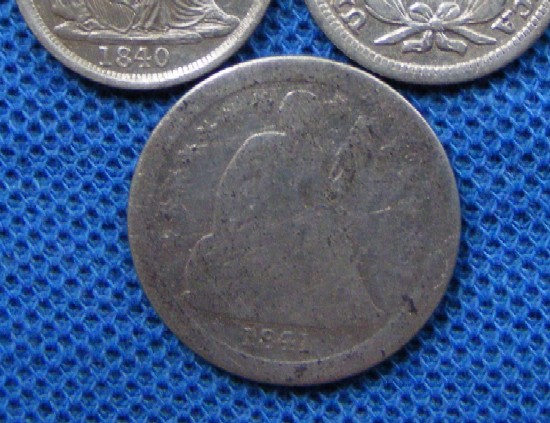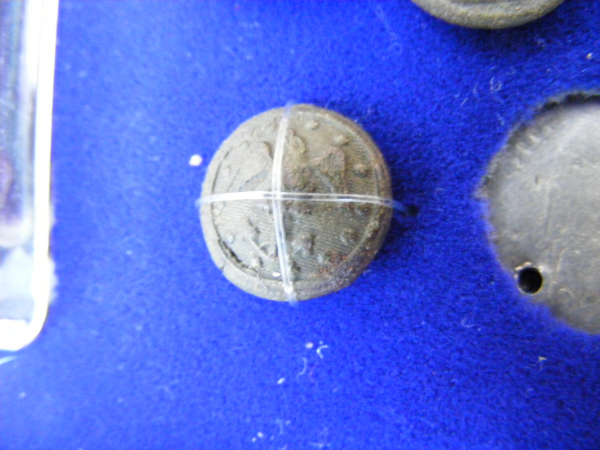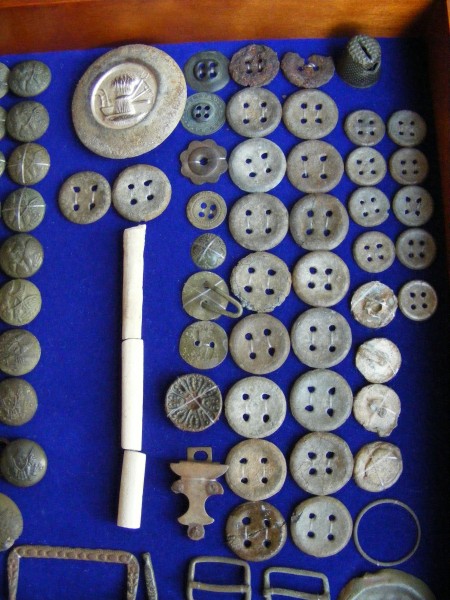

Contents
Menu


Have a Nice Day
--------------
--------------
Copyright 2005,
Dankowski Detectors.
All rights reserved.
Fort Meade, Florida
Third Seminole Indian War
Archaeological Metal Detecting Project
Thomas J. Dankowski
Continued from Page 1...
Underneath the gold coin is a 'holed' 1774 half-reale. "Holed" for the purpose of keepsake safety by running a string thru a bunch of 'holed' coin...then tied off so as not to lose any. This coin was used as a 5-cent (Half Dime) denomination. As can be witnessed, it has approx three quarters of a century of 'wear' (circulation) on the coin. During this time-period, it was common to see Spanish currency still in circulation...all the way up to...and including...the Civil War.

The coin to the right of the 1774 half-reale is a 1841 'O' dime with approx 11 years of circulation/wear. It was located at Ft. #2; just outside the Southeast fence of Heritage park, behind the pistol shooting stand.

Underneath these two silver coins are three silver Half-Dimes. From left-to-right; 1836 Bust Half-Dime, 1857 Seated Liberty Half-Dime and an 1840 Seated Liberty Half-Dime. All three were found on the golf course underneath a solo approximately 300 years old Oak tree. The 1857 Half-Dime was located 25-feet West (slightly West North West WNW) of the large Oak tree. The 1836 and 1840 Half-Dimes were 12-feet to the South of the large Oak tree...and both coins were approximately 28-inches apart (laterally) from each other; most probably lost at the same moment in time...by the same person. The 1840 Half-Dime is nearly Uncirculated and the 1836 Half-Dime is in VF-20 (Very Fine) condition (approx 4-years of circulation) ...collectively; a significant gauging data-point.

The two buttons flanking the gold coin (one on left, one on right) are Kepi buttons; circa 1828. One was found on the golf course; the other found at Ft. #1.

The button just to the left of the 'holed' half-reale is the only Navy button ever found at this site. This is not enough quantification/evidence/data to validate Navy presence. It was located at Ft. #2. Circa 1844.

Underneath all of the coins is a row of gold-gilt buttons. These are officer buttons. From L to R: Buttons 1, 3, 4 & 5 were all found at Ft. #2 on the South side of 3rd St...across from Heritage park; hence the justification of "Officers Quarters". The button in the center is a U.S. Great Coat button; circa 1829. The button just to the right of the U.S. Great Coat button is an unrestored...in its natural "dug" state... gold-gilt 'A' Artillery button. Notice the 'A' in the center of the breast. Buttons 1, 2 and 5 are fully restored....as can be witnessed by the high-gloss gold-gilt. There is value in full restification of artifacts....and there is (possibly even greater) value in "as is" unrestored relics. The button just to the left of the U.S. Great Coat button was found on the golf course... and is circa 1828.



To the left and right side of the '4' and 'I' are 7 large coat buttons. All of the rest of the buttons are smaller 'cuff' buttons. The one button just to the left of the '4' is a New York Staff Militia "Excelsior" button; circa 1881. This button is a 'one-off' fluke/freak button that is completely incongruent with the 1849-1854 era U.S. Army relics. The large coat button just to the left of the one (and only) 'I' Infantry button (just above the gold coin) is also a 'A' Artillery button; however, with its back-markings, it is from circa 1831.
The large triple column of smaller 'cuff' buttons are primarily 'A' Artillery buttons, with a few being 'general service' buttons. Nearly all of the military buttons in this display case are from Mfr "Scovills" (with an 's')....circa 1840-1850. It was not uncommon for buttons to be manufactured in large quantities....then delivered to the troops 5 or 10 years later...then lost months and/or years later.

On the very top and to the right-of-center is a large, round silver-dollar looking device. This is a horse bridle rosette. A decorative piece that usually adorned a officers horse... or civilian in nature. Found on the South side of 3rd St. directly across from Heritage park at a depth of 17 inches.


Just below the rosette is what appears to be a pencil that is broken in 3 places. These items are 3 pieces of clay pipe-stem. All three were 'sifted' from underneath the primary building at Ft. #1.
On the very right side of the display case are 4 columns of primarily pewter 'undergarment' buttons. These buttons are difficult to detect, as they are very low conductors. The two top most 'undergarment' buttons are made out of iron....and were 'sifted' from underneath the primary building at Ft. #1. They were found with a large rare-Earth magnet.

In the very upper right corner of the display case is a modified/customized sewing thimble. Notice the 'slit' in the top of the thimble. Notice the 'diamond shaped cutout' on the side of the thimble. The seamstress was most probably an older woman of whom was losing her eye-sight. The eyelet of the military buttons would fit perfectly into the 'diamond cutout' of the thimble... then a needle and thread could be run through the top slit, then into the eye of the button and then out the bottom of the thimble. This would facilitate and expedite the threading of the needle and thread to the button, followed by a more efficient way to attach the button to the clothing device.

In the lower right hand corner of the display case are various items of implement. Buttons, buckles, retainers. One of the items in the lower right is a half-moon shaped device with many small holes in it. This is called a toe-tap...to be worn on the tip of a shoe. It has a patent date of Nov 28, 1863 embossed into the top-center. The device was found at Ft. #2, believed to be lost during the summer/fall of 1864....and was usually worn by Civil War Union soldiers. This is the only device found/recovered that is of 'newer' era; that being from the Civil War.

In the very lower right corner of the display case is a item of significant 'electronic' value; indicative of current detection device (metal detector) capabilities/limitations and the 'current technology' sensitivity-level thereof. The item is a very small eyelet off of a military button that was found independently of any other item. Currently (March 2009), the best technology metal detector will detect this small eyelet to a depth of approx 3-inches. (Addendum/Update: Sept 2009 Fisher F75 "LTD" prototype will detect this eyelet to a depth of 4-inches.....a 33% improvement in technology).
The heavily 'dented & pointy' device above the pommel is a scabbard tip....that has seen heavy usage.

Bottom center is a flintlock hammer; most probably belonging to a 1816 Kentucky rifle. It was 'sifted' out of Ft. #1. This piece is incongruent with the rest of the relics......as the weaponry utilized for the 3rd Seminole Indian war were primarily percussion cap devices; however, it was not uncommon to have a rifle passed down thru a generation (or two)....and possibly utilized for the 3rd Seminole war.
Just to the right of the flintlock hammer is a pommel to an Army sword. Found at Ft. #1.

Directly above the flintlock hammer is a textbook perfect Indian arrowhead. It was found on the golf course. Whilst recovering a .69 Cal musket ball....and recovering a non-metallic Indian arrowhead in the same dirt 'mix' is rather ironic; both being projectiles from opposite sides (friend and foe; respectively).

CLICK HERE to continue to Page 3
CLICK HERE to go back to Page 1
.
Return to Top of Page
Page views since October 1, 2016
